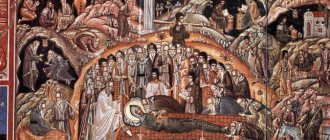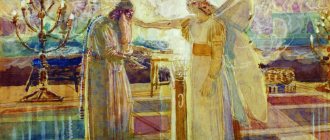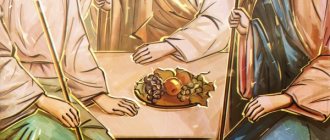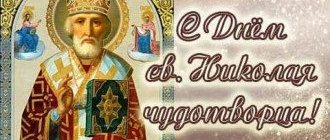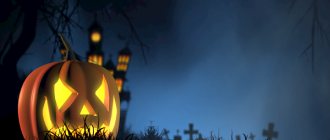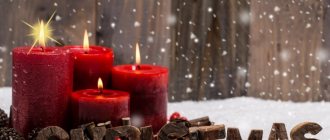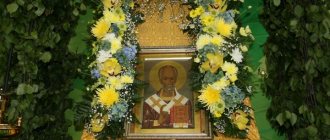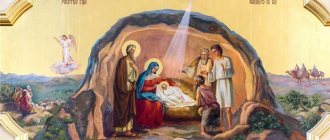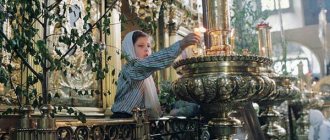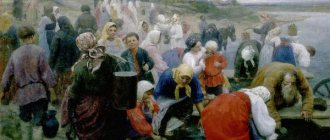The history of the holiday of the Nativity of Christ has been known since the emergence of Christianity. Since the 4th century, the holiday was called Epiphany, celebrated on December 25 and was a union of several events, which today are known as three separate holidays: Epiphany (Epiphany), Annunciation and Christmas.
The appearance in the flesh of the Son of God, the remembrance and glorification of this event is the main and original goal of the bright holiday of the Nativity of Christ. But there is also a secondary goal, which we will find out in this article.
When is Christmas and Christmas Eve celebrated?
Orthodox Christians celebrate Christmas on January 7th. This bright holiday is preceded by another important date - the evening of January 6, when Christmas Eve or, popularly, “Carols” begins. Christmas Eve falls on the final day of the Nativity Fast; zealous Christians traditionally ate nothing but sochiv – soaked wheat grains with honey and fruit – all day on January 6th. Hence the name of the Christmas Eve. And only with the lighting of the first star in the sky, the whole family sat down at the festive table to taste 12 Lenten Christmas dishes.
Catholics celebrate Christmas on December 25th according to the Gregorian calendar.
The bright holiday of Christmas - symbols and customs
Christians have long had traditions of celebrating this bright holiday. Much attention is paid to decorating the house and preparing festive dishes. The main attribute of the celebration is spruce or pine. It is generally accepted that the branches of this tree were used by Christ’s parents to disguise the entrance to the cave where the newborn Christ was.
This is where the tradition of hanging an elegant wreath above the front door came from. Each Christmas tree decoration also has its own backstory. The red star crowning the top of the tree is mistakenly considered by many to be a relic of Soviet times. But the Kremlin Christmas trees have nothing to do with it. The tip symbolizes the Star of Bethlehem, which, according to legend, notified the world of the birth of the son of God.
An angel descended from heaven carrying the good news of the appearance of the Savior of the world. Following him, a whole army of white-winged creatures descended to earth, welcoming the newborn with heavenly singing. So the many angels on the branches of the festive fir tree also refer us to the solemn event.
Bells, which are also used to decorate the Christmas tree, are a legacy of the pagan faith. It is believed that their chime scares away evil spirits. Candles are considered an indispensable attribute of the holiday, the fire of which symbolizes divine light. Traditional Christmas colors: white, gold, red, green.
In addition to the traditional decoration of the house, on the eve of Christmas it is customary to carry out general cleaning. The housewife carefully cleans the furniture and kitchen utensils, throws away old things that the family has not used for a long time. The sacred meaning of such a ritual is to cleanse the house of negativity, opening the way for energy cash flows.
Christmas story
Today is Christmas - one of the main Orthodox holidays. It marks the annual miracle - the birth of Jesus, who was born in a manger for feeding livestock.
According to biblical legend, the birth of the Savior was announced by the Star of Bethlehem, which shone in the sky. The Magi saw this sign and hastened to congratulate the Virgin Mary on the birth of her son, bestow gifts on him and worship him as the new king of Judea. This plot is often used in painting: world-famous artists have created and are creating works based on the birth of Jesus. Among them is the unfinished painting by Leonardo da Vinci “The Adoration of the Magi” (1481-1482). And also the work of Peter Paul Rubens with the same name.
In fact, there is no exact date when Jesus Christ was born. Moreover, the holiday of the birth of the god of the winter Sun - Kolyada - was celebrated by our Slavic ancestors long before the establishment of the Christian faith. The ancient pagans worshiped the Sun, and the dates when it was at its lowest height from the Earth (Winter Solstice) were considered the most important. Usually this was the period from December 25 to January 7. In some regions - from December 22 to January 6. In pre-Christian times, a huge number of rituals, magical actions and signs fell on these days. Christmas carols were not complete without beliefs, ritual songs, and prohibitions.
Symbols of the Nativity of Christ
The following are the most famous symbols of the Nativity of Christ:
- elegant Christmas tree;
- present;
- Star of Bethlehem;
- nativity scene;
- angels and shepherds.
The history of the emergence of spruce as an attribute of Christmas comes from the Western tradition, which did not develop immediately, and was associated with people’s ideas about evergreens as a symbol of immortality, eternal life. That is, exactly what became possible with the coming of the Savior to this world.
Gifts were brought to Christ by the Magi - Persian healers, representatives of Zoroastrianism - the world's first monotheistic religion, intended for all peoples, and not just for the Jewish. They practiced astrology and calculated the Birth of the Messiah, which was predicted in their religion. The Magi brought with them gifts to the Christ Child - attributes that symbolized three important qualities that He possessed. It was:
- gold - to the King;
- incense - to the Priest;
- myrrh - To a man who must die.
Myrrh is a very aromatic resin that was used to pray over dead people and was a symbol of burial. After returning to their homeland, the Magi preached the birth of the Savior. The Church honors them as the “three holy kings.” In memory of these gifts, it is customary to give gifts at Christmas - not because the person behaved well, not for any other reason - but out of love, for Christ's sake.
The Star of Bethlehem is a mysterious celestial object that led the Magi to Christ. According to one version, an unusual celestial phenomenon occurred when Jupiter and Saturn converged at one point. According to the calculations of the astronomer Johannes Kepler, who lived in the 17th century, such a phenomenon could have been possible during the events of the Gospels. There are different traditions in the depiction of the Star of Bethlehem - the 5-pointed star, characteristic of the Arab Church, is known, the 8-pointed one is considered a symbol of the Virgin Mary and is depicted in the Orthodox tradition. There are also 6-pointed and other types of the Star of Bethlehem.
It is reliably known from Tradition that there was no place for Christ in the hotels of Bethlehem, where the Holy Family came for the census, and He was born in a cave (den) and was swaddled and laid in a manger - a feeding trough for livestock. Therefore, pious Christians place a figurine of a nativity scene with the Child and the Holy Family under the Christmas tree - in memory of the great event.
According to the Gospel narrative:
“In the vicinity of Bethlehem there were shepherds who lived in the field and, replacing each other at night, guarded their flock. And the angel of the Lord appeared before them. The radiance of the light of the Lord illuminated them. They were very afraid, but the angel told them: “Do not be afraid! I bring you good news - news of great joy for all the people: today in the city of David your Savior was born - Christ the Lord! And here is a sign for you: you will find a Child swaddled, lying in a manger.” (Luke 2:8-12)
The shepherds saw the angels, heard the Great Doxology, the angelic song that people preserved, believed and came to worship the Creator first.
“Glory to God in the highest, and on earth peace, good will toward men!” (Luke 2:14)
In memory of this event, shepherds and angels became symbols of the Nativity of Christ. They are depicted on Christmas gifts, as Christmas tree decorations, Christmas figurines and other symbols that are traditional attributes of Christmas.
Merry carol: the main tradition of Christmas
The combination of two religions - paganism and Christianity - gave rise to an extraordinary number of rituals and traditions that have survived to this day. After the baptism of Rus' and the establishment of the doctrine of one God, the pagan context in the celebration of carols gradually faded into the background. However, it did not disappear completely, and the proof of this is carols - folk ritual songs praising the miracle of the birth of Christ. There are also earlier copies where the Sun, carols are mentioned, and wishes for a good harvest in the new year are heard. They are performed by dressed up boys and girls, as well as men, women, and children who go from house to house and wish everyone a Merry Christmas.
Receiving such guests is a good omen, which symbolizes good luck, prosperity and a good harvest for the next year. In gratitude for caroling, people usually give sweets, fruits, pastries , or small amounts of money. Christmas carols are present in the folklore tradition of most Slavic peoples: Belarusians, Ukrainians, Russians, Poles, Czechs, Slovaks, Bulgarians.
Another authentic phenomenon is considered to be a Christmas nativity scene, in which there are characters depicting a goat, a devil, a priest and other heroes.
The history of the Nativity of Christ holiday
Christmas is a great Christian holiday celebrated all over the world.
This is a holiday of peace and tranquility. Christmas is officially the celebration of the birth of Jesus Christ, the son of God in Bethlehem.
The first information about the holiday dates back to the 4th century. It is from that time that the great holiday has been celebrated. Although the birth itself, its date and place of birth of Jesus is a controversial issue even among church people. Until the 5th century, all Christians of different denominations celebrated the Nativity of Christ and Epiphany on January 6th. This was caused by persecution and restrictions on the freedom of all Christian worship.
In many churches in the east, this holiday was called by a common name - Epiphany . The reason for this was that it was believed that Christ was baptized on the day of his birth.
John Chrysostom stated this in his conversations about the Nativity of Christ: “... it is not the day on which Jesus was born that is called the Epiphany, but the one on which he was baptized.” The Evangelist Luke also testified to this.
Evidence of the merging of the holidays of Christmas and Epiphany to this day is the similarity in the celebration of these dates by the Orthodox Church. Christmas Eve is common, with the same legend that one must fast until the morning star.
The Day of the Nativity of Christ is considered by the Christian Church to be a great holiday, a greatest and miraculous event. This event is accompanied by the wondrous news, “as the Savior has been born,” and the worship of the Savior.
Christmas began to be celebrated separately from other holidays only after the 5th century. It was then that this holiday reached the West.
With the introduction of two calendars: the Julian and Gregorian, the celebration of this bright day began to be celebrated by different churches on different days.
According to the Gregorian calendar, Christmas is celebrated on December 25th. It is on this day that Christians of the Roman Catholic and Protestant churches celebrate Christmas. It was on this day that the pagan holiday “Birth of the Invincible Sun” was once celebrated.
The remaining churches: Russian, Serbian, Georgian, Jerusalem, Mount Athos, Eastern Catholic and Ancient Eastern; they all celebrate Christmas on January 7th. This corresponds to the date on the Gregorian calendar.
According to the hypothesis of modern historians, the choice of the day to celebrate Christmas was made because of the celebration of the Incarnation (the day of the conception of Christ) and Easter on the same day. If you add 9 months to the date (March 25), you get December 25 - the winter solstice.
Basically, December 25 is the day of Christmas, which is celebrated by most Christians. The holiday itself is quite broad. It is divided into preliminary celebrations, lasting from December 20 to 24, and post-festivities (until the New Year itself).
On the eve or Christmas Eve, strict fasting is observed. According to traditions, on this day you can only eat juice - barley or wheat grains boiled with honey. The fast ends with the appearance of the first evening star in the sky.
On the eve of the holiday, believers remember the prophecies of the Old Testament and the events associated with the birth of Christ. Divine services dedicated to this great holiday are performed by clergy 3 times, symbolizing:
1. At midnight - the Nativity of Christ in the bosom of God the Father 2. At dawn - in the womb of the Virgin Mary the Mother of God 3. During the day - in the soul of every person.
Only in the 13th century, with the advent of the time of Francis of Assisi, did the custom of worshiping Jesus in a manger come about. Over the years, mangers began to be installed not only in churches, but also in homes on Christmas Eve. Scenes from life were often depicted, where figures of ordinary people were located next to the saints.
In the celebration of the Nativity of Christ, the customs of peoples and church rituals are intertwined. This is clearly seen in caroling.
When children and youth go from house to house, congratulating their residents. For wishes and congratulations, carolers receive delicious gifts: candies, sweets, fruits. Stingy owners are threatened with trouble.
During caroling, mummers in different clothes pass by. Church authorities condemned this ritual. Over time, they began to carol when visiting neighbors or relatives.
An attempt to reconcile paganism and Christianity was the burning of a “Christmas log” in the hearth. They brought a log into the house, performed rituals, carved a cross on it and, while praying, burned it.
At Christmas, there was a ritual of eating unleavened wafers, blessed in the church, before the festive meal. Congratulations were offered at the breaking of unleavened bread.
It was with the beginning of the Christmas celebration that the custom of placing decorated coniferous trees in homes was established everywhere.
This tradition was once pagan and originated among the Germanic peoples. Spruce is considered a symbol of life and fertility.
Spruce was first mentioned in the 8th century, when the monk Boniface cut down an oak tree, but when it fell, it broke all the trees in the area except spruce. Seeing this miracle, the monk illuminated the remaining tree and declared the spruce to be the “tree of Christ.” Over time, this tradition acquired new symbolism.
A spruce tree decorated with balls and toys, installed on Christmas Eve, symbolizes the tree of paradise with the fruits of abundance.
An evergreen wreath with bells and candles, which is usually hung on the front door, symbolizes the Heavenly Bells and drives out evil spirits.
At Christmas, cards are given, candles are lit, carols are sung. During the 12 days of Christmas, it is customary to give gifts and sing joyful songs praising Jesus.
At Christmas people often tell fortunes and make wishes. This is also part of paganism that has passed into Christianity. There is a belief that if you rearrange things in your closets and change their places on the eve of Christmas, your family will have plenty all year round.
The tradition has reached our times of congratulating all relatives and friends on Christmas, wishing them every possible well-being.
How to celebrate Christmas and Christmas Eve?
On Christmas Eve, January 6, the whole family traditionally gathers around the festive table, consisting of 12 Lenten dishes. The meal begins after the first star appears in the sky, which notified the Magi about the birth of Jesus. In some regions, not only relatives, but also godchildren of the owners come to visit on Christmas Eve. They need to prepare treats and gifts.
, kutia, uzvar (dried fruit compote), cabbage rolls with potatoes, fish, sauerkraut and baked apples are placed on the table . After dinner, you should leave some kutia in the plate so that the spirits of deceased relatives can taste the Christmas dinner.
On the morning of January 7, all family members go to church for prayer, and only then celebrate Christmas at a rich (meat) table. Jellied meat, baked sausage, and alcoholic drinks are already present here.
Folk celebration traditions in Russia
Folk traditions of celebrating Christmastide from Christmas to Epiphany are rooted in the Slavic customs of celebrating the winter solstice. Mandatory attributes of the holiday were dressing up (massaging using skins, masks and horns), caroling (visits to houses by a group of fellow villagers who performed “well-wishing” sentences and songs addressed to the owners of the house, for which they received treats), carol songs, or carols, youth games and fortune telling.
Article on the topic
Dashing Christmastide. On these days, things were allowed that were unacceptable at other times. Christmastide began on Christmas Eve with dinner with Christmas kutya and porridge, pie with pretzels, and for the holiday, animal figures were baked from wheat dough, which were used to decorate tables, hut windows and which were sent as gifts to relatives and acquaintances When the family gathered at the table, the elders remembered the year - all the good and bad in the past year. At the end of the meal, the children took part of the remaining kutya to grandparents, as well as to the poor, so that they too could celebrate Christmas. In some places, food and tablecloth were not removed from the table until the morning, believing that the souls of the deceased parents would come to the table to also eat.
Then the mummers, dressed in sheepskin coats with the wool upside down and animal masks, in order to be unrecognized, staged dances in houses and on the streets, staged skits and entire performances. At the end of the 17th century, nativity theater came from Poland to Russia: in a special den-box, scenes about the birth of Jesus Christ and other scenes were acted out with the help of dolls.
Fragment from "Rat Hawks". Photo: Commons.wikimedia.org / Hvar
Echoes of pagan beliefs were also evident in the fact that it was customary to tell fortunes on Christmastide. In some villages, straw was burned on Christmastide - according to legend, dead ancestors came to warm themselves by the fire at these moments. The Church, not approving of witchcraft superstitions and pagan rituals, assimilated “harmless” customs, and they organically entered people’s life.
For Christmas, the owners always cleaned the house, washed in the bathhouse, laid out a clean tablecloth, stocked up on new clothes, which they put on at the beginning of the day, and invited single people to Christmas dinner. But in some places, superstitions associated with the holiday were also widespread: they did not drink plain water at breakfast, since it was believed that a person who drank water on Christmas morning would be thirsty all summer. On pain of all sorts of troubles, nothing could be bent, weaved or sewed on Christmas Day. The legs of the dining table were tied to each other with a rope so that the cattle would not run away from the herd. The remains of the evening meal were taken outside the fence - “so that the wolves would not harm the peasant cattle.”
Article on the topic
Piglet, spelt and lamb sausage. 4 ancient dishes for Christmas
Traditional on the Christmas table were a variety of pork dishes: jellied meat, roasted pig, stuffed pig's head, roast. Baked birds and fish, fried and baked meat in large pieces were also served on the Christmas table, since the design of the Russian oven made it possible to successfully cook large-sized dishes. Finely chopped meat and offal were cooked in pots along with traditional porridge. A variety of pies were also filled with meat: rolls, cheesecakes, koloboki, kulebyaki, kurniks, pies, etc. They prepared casseroles and pancakes. In addition to meat fillings, a variety of vegetable, fruit, mushroom, fish, curd and mixed fillings were prepared.
“Poor” kutia: what you definitely need to cook on Christmas Eve
Read more
What you can do for Christmas: main traditions and rituals
On the bright holiday of the Nativity of Christ, relatives and friends, dear and long-awaited guests are invited to visit. It is also worth remembering your deceased relatives, lighting a candle and reading the Lord’s Prayer. According to custom, the owner brought a sheaf of rye or wheat into the house, which was placed in the corner of the table under the icons. This is the so-called didukh, grandfather or carol, personifying the well-being and prosperity of the family.
On Christmas night, all doors and windows should be opened to let the holiday into the house. It is also customary to go around your entire household, thank your pets and treat them to something tasty. On Christmas Eve, the owner of the house also goes around to all the guests and family members, treating them to honey and pastries. At the same time, you should say good words and wishes.
History of the holiday in Russia
The holiday of the Nativity of Christ became a celebration after the baptism of Rus' by Prince Vladimir at the end of the 10th century. Christmas took second place in importance after Easter among the public holidays of the Russian state. And after the victory over Napoleon, the holiday of the Nativity of Christ in the Russian Church is associated with “the memory of the deliverance of our fatherland from the Gauls and with them twelve languages in 1812.”
By the end of the 19th century, the holiday of Christmas had become not only a religious, but also a secular celebration. In the Russian Empire, the law prohibited “on the eve of the Nativity of Christ and during Christmastide, according to ancient idolatrous legends, starting games and, dressing up in idol robes, performing dances in the streets and singing seductive songs.” By the beginning of the 20th century, a decorated Christmas tree, under which Father Frost, the Russian analogue of the Western Santa Claus, brought gifts, became an indispensable attribute of Christmas in both the city and the countryside.
Article on the topic
How the traditions of celebrating the New Year and Christmas changed in Russia During the Soviet period, Christmas, like other religious holidays, was eradicated by the state. The Christmas tree and its associated festivities became part of the secular celebration of the New Year. The “Christmas” tree in modern Russia has become a “New Year’s” tree; gifts from Santa Claus have also become part of New Year’s traditions. After the collapse of the Soviet Union, no reverse transformation occurred - the New Year remained the main traditional holiday.
In modern Russia, Christmas became an official holiday in 1991, when January 7 became a non-working day. In subjects of the Russian Federation whose population professes other religions, instead of January 7, another holiday may be established - in this case, January 7 is a working day for these subjects of the Russian Federation.
What not to do at Christmas
Rituals, ceremonies and traditions of Christmas are associated with a number of prohibitions and taboos that our ancestors have long observed.
- On Christmas Eve you cannot sit down at the table until the first star appears.
- During Christmas dinner, you should not talk loudly or leave the table until the meal is finished.
- It is also not advisable to overeat at the festive table - it is better to try a little of each dish.
- Unmarried boys and girls are prohibited from sitting on the corner of the table.
- You can't swear or use foul language at Christmas.
- You cannot do cleaning or other household chores (except cooking).
- Some sources report that you cannot tell fortunes on the Christmas holiday, and if you really want to know your future, it is better to carry out rituals after January 8th.
How to attract good luck and prosperity
There are many signs associated with Christmas, as with the New Year. It is customary to celebrate the holiday with pure thoughts, so there should be no quarrels or scandals in the house. Please note that doing your hair or washing on religious holidays is prohibited.
Therefore, take care of beauty and cleanliness in advance. Clothes should be smart, light colors, preferably new. The table is set for an even number of guests. There should be no empty plates; this promises financial troubles for the whole year. With the appearance of the first star, candles are lit at home and a fire is lit in the fireplace.
When midnight comes, the owners open the front door, letting in the Christmas spirit. In order for the family to enjoy prosperity all year round, one should not spare money on decorating the house and treats.
The housewife must feed not only family members, but also pets. You also need to come to visit not empty-handed. And let the gifts on this day be special, handmade, cozy and warm. You can prepare Christmas-themed cards in advance.
All kinds of treats are suitable for this purpose: pickles, marinades, jam, sweet pastries generously seasoned with candied fruits and cinnamon. Handmade accessories are also presented for the holiday: scarves, mittens, socks, or Christmas-themed souvenirs.
On Christmas Eve it is also customary to make wishes; it is believed that they will certainly come true if done correctly. The ritual is carried out with holy water, which must first be brought from the church. The liquid is poured into a glass and at exactly 12 am they empty it in small sips, focusing on their goals. Of course, your thoughts should be exclusively good.
The church holiday suggests that believers should pray, rest and rejoice at the birth of Jesus. Attendance at the ceremony is mandatory. You cannot remember the dead in your prayers on Christmas Day. Doing housework, doing handicrafts, hunting or fishing on such a day is also not allowed.
Christmas fortune telling
If you still decide to perform fortune-telling rituals on Christmas, perform the simplest and most harmless one. Pour water into a bowl, then light an unconsecrated candle and gradually drip wax into the water. What the resulting pattern looks like is what your future will be.
On Christmas night, young girls put a comb under their pillow with the words: “Mummer, comb my head.” Whoever the girl sees in her dream will be her groom. Also, fortune telling with a shoe was common among our ancestors. The girl took off her shoes from her left foot and threw them over the gate. In which direction the toe of the shoe is pointed, in that direction the girl will get married. And if the sock is turned back towards the house, she will remain a girl for another year.
Signs for Christmas
- If a woman enters the house first at Christmas, the owners will be sick all year.
- It's a bad omen to lose something at Christmas. It leads to losses and disappointments.
- But finding something valuable means profit and prosperity.
- If you accidentally spilled tea or coffee at the Christmas table, you will have good news this year.
- The main Christmas sign concerns natural phenomena. If at Christmas the sky is strewn with stars and there is a lot of snow, the years will be successful, rich and satisfying.
Christmas - a brief history of the holiday
The Ever-Virgin Mary was carrying Jesus in her womb when a decree came from Rome to take a census of all the inhabitants of Palestine. People were obliged to come to the cities where they were born and register there. Joseph and Mary went to their hometown of Bethlehem. But there were too many people there at that time that both the hotels and the houses of local residents were occupied by parishioners, so the owner of one house showed them a cave where in winter he hides his cattle from the cold wind.
It was in this cave that on the significant night of January 7, Jesus was born, and a star lit up in the sky, which stood out among the rest with its brightness (hence the name Star of Bethlehem). Herod, the king of the Jews, seeing this miracle in the sky, realized that the Savior had been born and became very worried, because the Baby was predicted to become a king!
At this time, the Magi came to him, to whom it was revealed that the Infant God had been born, and they sought to find Him and present Him with gifts. Herod, having learned that the Baby was born, told the wise men to tell him about the place of birth, ostensibly in order to praise Him, but in fact to destroy Him.
The Magi went on a search, they were led by a star. When they arrived in Bethlehem, Joseph and Mary were no longer in the cave, but in the house. The Magi presented gifts to Jesus: gold (revere in it the future king), frankincense (seeing God in it) and myrrh (suggesting that as a man, he is mortal).
The angels told the wise men not to return to their king, knowing what he was planning. Herod, in anger, ordered the destruction of all the babies around the age of Jesus, and Joseph, Mary and the child went to Egypt, away from Herod and returned to their homeland after his death.
Since then, the Orthodox believe that the most important holiday is the Nativity of Christ. All day and all night, services are held in churches, candles are lit, and joyful carols are sung. Holidays (Svyatki) last until Epiphany, which is celebrated by the Orthodox on January 19.
